
Immediate Post-Operative Care
After tooth extraction, immediate care is critical for healing. Bite on gauze for 30-45 minutes to control bleeding. Avoid disrupting the blood clot, as it aids recovery. Use ice packs to reduce swelling and rest to promote healing. Do not rinse, spit, or use straws for 24 hours to protect the extraction site.
1.1. First 24 Hours After Tooth Extraction
During the first 24 hours after tooth extraction, prioritize rest and avoid strenuous activities. Keep the gauze in place for 30-45 minutes to control bleeding. Avoid rinsing, spitting, or using straws to protect the blood clot. Apply an ice pack to the cheek near the extraction site to reduce swelling. Stick to a soft-food diet and avoid hot or sharp foods. Do not smoke or consume alcohol. Light bleeding is normal, but if it persists, contact your dentist. Monitor the extraction site for any signs of complications.
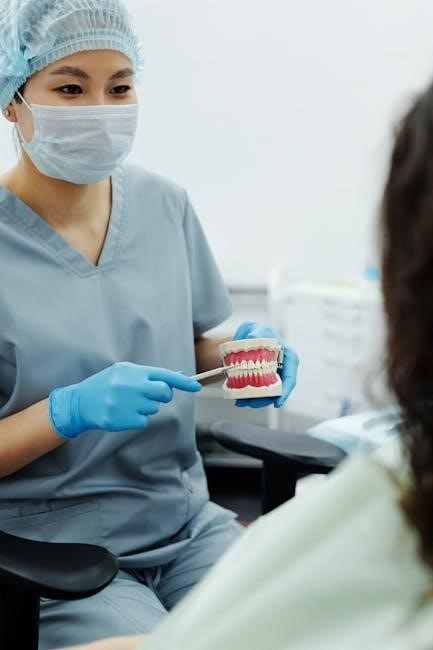
1.2. Importance of the Blood Clot Formation
The blood clot that forms in the extraction site is crucial for healing. It stops bleeding, protects the wound, and promotes tissue repair. The clot acts as a natural barrier, preventing infection and aiding in granulation tissue formation. Disturbing the clot can lead to complications like dry socket, a painful condition where the underlying bone and nerves are exposed. Protecting the clot ensures proper healing and reduces the risk of infection, making it vital to avoid activities that might dislodge it, such as rinsing forcefully or using straws.
1.3. Biting on Gauze for Bleeding Control
Biting on gauze is essential to control bleeding after tooth extraction. Patients should bite firmly on the gauze pad for 30-45 minutes to apply pressure to the wound. If bleeding persists, replace the gauze and continue biting. Avoid dislodging the blood clot, as this can prolong healing. If bleeding doesn’t stop after several attempts, contact your dentist. The gauze helps stabilize the clot, ensuring proper healing and minimizing complications. Follow post-operative instructions carefully to manage bleeding effectively.

Managing Bleeding and Swelling
Control bleeding with gauze and monitor for excessive bleeding. Reduce swelling by applying ice packs alternately for 20 minutes on and off. Consult your dentist if bleeding persists.
2.1. Controlling Bleeding with Gauze
Immediately after extraction, bite firmly on the gauze pad for 30-45 minutes to stop bleeding. If bleeding continues, replace the gauze and apply pressure for another 30 minutes. Repeat as needed. Avoid vigorous rinsing or spitting, as this can dislodge the clot and worsen bleeding. If bleeding persists despite these measures, contact your dentist promptly for further instructions. Proper gauze use is essential for a smooth recovery.
2.2. Using Ice Packs to Reduce Swelling
An ice pack or a bag of frozen peas wrapped in a cloth can be applied to the cheek near the extraction site to minimize swelling. Use it in 20-minute intervals (20 minutes on, 20 minutes off) during the first 12 hours. This helps reduce swelling and discomfort. Swelling typically subsides within 48-72 hours; If swelling persists or worsens, consult your dentist for further evaluation. Ice therapy is most effective when applied consistently in the initial recovery phase.
2.3. Monitoring for Excessive Bleeding
Some bleeding after tooth extraction is normal, but excessive bleeding requires attention. Check for large blood clots or heavy bleeding. If bleeding persists, apply firm pressure with gauze for 30 minutes. Replace the gauze if needed and repeat. If bleeding doesn’t stop or increases, contact your dentist immediately. Monitor for signs like blood-tinged saliva, which is normal, versus active bleeding. Excessive bleeding may indicate complications, so seek professional help promptly to ensure proper healing and prevent further issues.
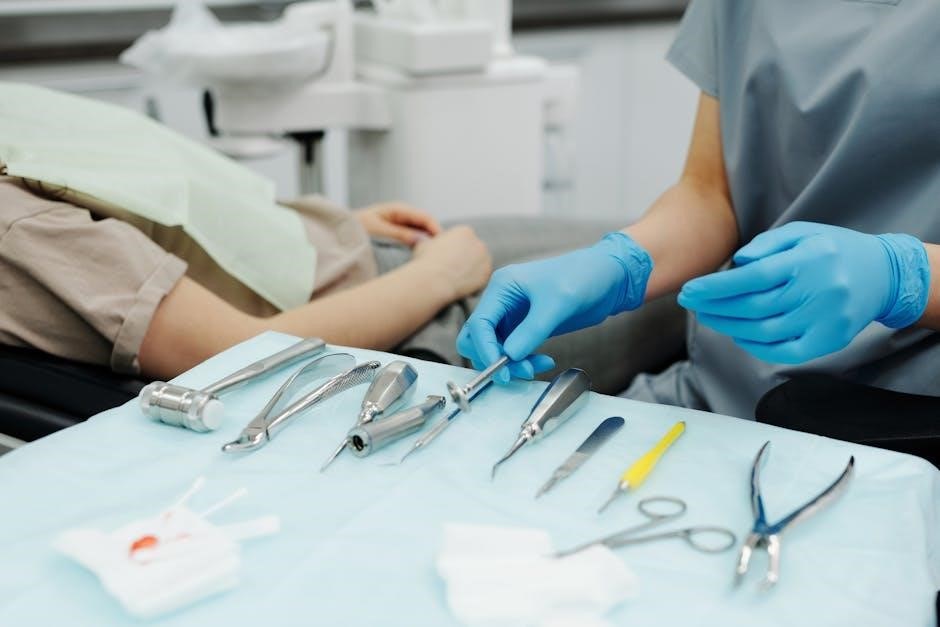
Dietary Recommendations
Eat soft, nutritious foods like yogurt, applesauce, and scrambled eggs. Avoid hard, sharp, or hot foods that may irritate the extraction site. Stay hydrated with water or clear broths, but avoid using straws.
3.1. Eating Soft Foods After Extraction
Eating soft foods after tooth extraction is essential to avoid irritating the extraction site and promoting healing. Opt for foods like yogurt, scrambled eggs, mashed potatoes, applesauce, and smooth soups, which are gentle on the mouth. Avoid hard, crunchy, or sharp foods that could dislodge the blood clot. Staying hydrated is important, but avoid using straws, as the suction can disrupt the clot. By choosing the right foods, you support a smooth recovery and minimize the risk of complications.
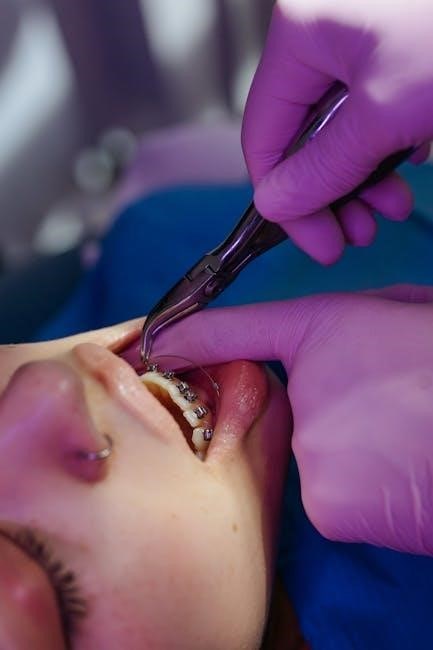
3.2. Avoiding Hot, Hard, or Sharp Foods
Avoid consuming hot, hard, or sharp foods after tooth extraction to prevent discomfort and protect the extraction site. Hot foods can irritate the sensitive area, while hard or sharp foods may dislodge the blood clot, leading to complications like dry socket. Opt for soft, lukewarm foods instead, ensuring gentle care for the healing site. This precaution helps maintain the integrity of the clot and supports a smooth recovery process.
3.3. Staying Hydrated Without Using Straws
Staying hydrated is crucial for recovery, but avoid using straws to drink liquids. Suction from straws can dislodge the blood clot, leading to complications like dry socket. Instead, sip water or other fluids directly from a glass. Avoid carbonated or alcoholic beverages for 24 hours, as they can irritate the extraction site. Gentle hydration supports healing without disrupting the clot. Continue this precaution for at least 24 hours to ensure proper recovery and minimize risks of post-operative complications.

Oral Hygiene and Care
Maintaining proper oral hygiene is essential for healing. Rinse with warm salt water after meals, gently brush around the extraction site, and avoid forceful spitting or rinsing.
4.1. Rinsing with Warm Salt Water
Rinsing with warm salt water after meals helps keep the extraction site clean. Start 24 hours post-extraction, mixing 1 teaspoon of salt in 8 ounces of warm water. Gently swish the solution around your mouth for 30 seconds, then spit it out. Continue this routine 1-2 times daily for up to two weeks. Avoid vigorous rinsing, as it may dislodge the blood clot. This practice promotes healing and reduces the risk of infection or complications like dry socket.
4.2. Brushing Gently Around the Extraction Site
Begin brushing gently around the extraction site 24 hours after surgery. Use a soft-bristled toothbrush and mild toothpaste, avoiding direct contact with the extraction site. Gently clean adjacent teeth in a circular motion to maintain oral hygiene. Avoid vigorous brushing, as it may dislodge the blood clot. For added comfort, soak the toothbrush in warm water before brushing to soften the bristles further. This careful approach helps protect the healing site while maintaining overall mouth cleanliness and reducing the risk of infection.
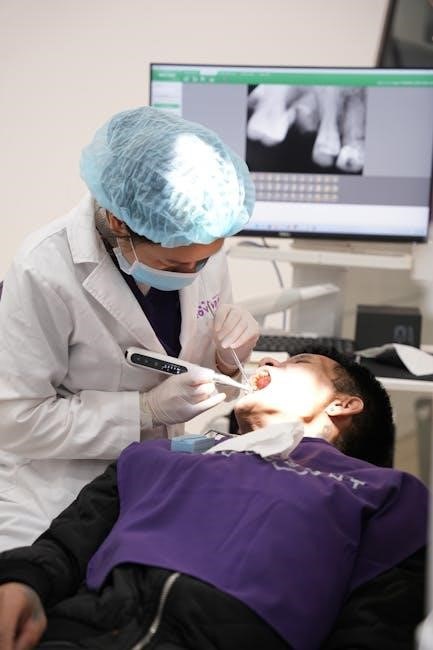
4.3. Avoiding Spit or Rinse Forcefully
Avoid spitting or rinsing forcefully for at least 24 hours after tooth extraction. This can dislodge the blood clot, delaying healing or causing complications like dry socket. Instead, gently spit if necessary, and rinse with warm salt water without force. Do not use straws or suck vigorously, as this can also disrupt the clot. Passive spitting or allowing saliva to drip is recommended. Avoid these actions for 3 days to ensure proper healing and prevent infection.

Preventing Complications
- Avoid smoking and alcohol for 24-48 hours to prevent dislodging the blood clot, which can lead to dry socket.
- Protect the extraction site from irritation by avoiding sharp or hard foods.
- Monitor for signs of infection, such as increased redness, swelling, or fever.
- Watch for excessive bleeding, as it may indicate complications requiring medical attention.
5.1. Avoiding Smoking and Alcohol
Smoking and alcohol consumption should be avoided for at least 24-48 hours after tooth extraction. Smoking can dislodge the blood clot, leading to dry socket, while alcohol can delay healing and increase the risk of complications. Both habits can irritate the extraction site, prolong recovery, and increase the chance of infection. Avoiding these habits ensures the blood clot remains intact and promotes a smooth recovery. Your dentist may recommend avoiding smoking for up to 72 hours for optimal healing.
5.2. Preventing Dry Socket
Dry socket prevention is crucial after tooth extraction. Avoid smoking, using straws, and vigorous rinsing for 24 hours. Gently biting on gauze helps form a protective blood clot. Avoiding hard or sharp foods and maintaining good oral hygiene also reduce the risk. If the clot dislodges, exposing bone and nerves, seek immediate dental care. Dry socket can cause severe pain and delay healing, so adhering to post-operative instructions is essential to prevent this complication and ensure proper recovery.
5.3. Recognizing Signs of Infection
Monitor for signs of infection after tooth extraction, such as increased redness, swelling, or pus around the extraction site. A foul odor, persistent pain, or fever may indicate infection. If symptoms worsen or last beyond a few days, contact your dentist immediately. Infection can delay healing and requires prompt treatment, such as antibiotics. Proper wound care and adhering to post-operative instructions reduce infection risk, ensuring a smooth recovery.
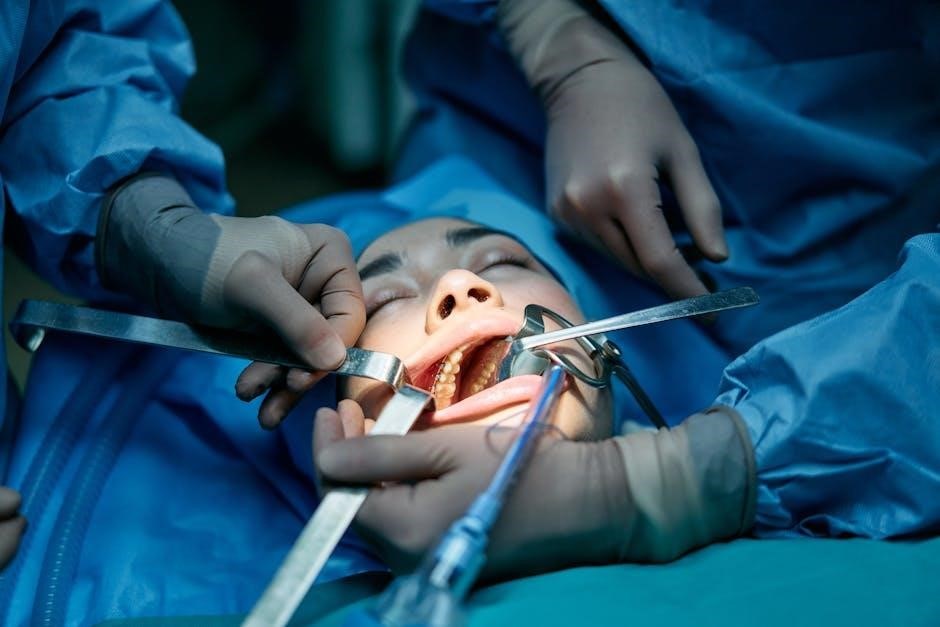
Recovery Timeline
Recovery typically begins with initial healing within 1-2 weeks, while full recovery may take up to 10 days or more. Follow-up appointments ensure proper healing progress.

6.1. Healing Process in the First Week
The first week is crucial for healing. The blood clot forms within 24 hours, and swelling typically subsides within 48-72 hours. Gentle saltwater rinses can begin after 24 hours to keep the site clean. Stick to soft foods, avoid smoking, and refrain from spitting or using straws to protect the clot. Monitor for signs of complications, such as excessive bleeding or pain, and contact your dentist if concerns arise. Proper care during this period ensures a smooth recovery and reduces the risk of infection or dry socket.
6.2. Full Recovery and Normal Activities
Full recovery typically occurs within 7-10 days, allowing patients to resume normal activities. Most individuals can return to work or school within a few days, provided they avoid strenuous tasks. Soft foods are recommended for 3-4 days, gradually introducing regular meals. Smoking should be avoided for at least 72 hours to prevent complications. Maintaining good oral hygiene and attending follow-up appointments ensures proper healing. Some sensitivity may linger, but full comfort usually returns within two weeks. Healing times may vary based on the extraction’s complexity and individual factors.
6.3. Follow-Up Appointments
Follow-up appointments are essential to monitor healing and ensure proper recovery. Typically scheduled 7-10 days post-extraction, these visits allow your dentist to check the healing progress, remove stitches if necessary, and address any concerns. Attend all appointments as instructed to ensure the extraction site is healing correctly. Your dentist may also provide additional care instructions or clear you for normal activities. These check-ups are crucial for preventing complications and ensuring a smooth recovery process.